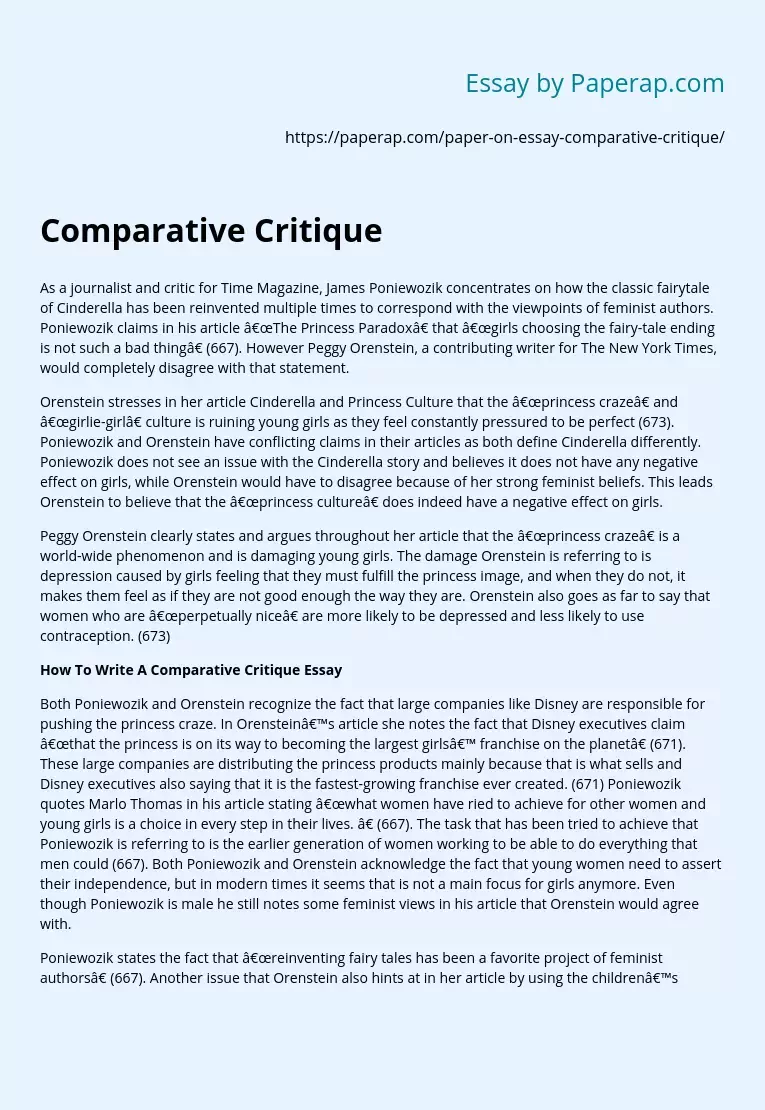Feminist Comparative Critique of Cinderella
As a journalist and critic for Time Magazine, James Poniewozik concentrates on how the classic fairytale of Cinderella has been reinvented multiple times to correspond with the viewpoints of feminist authors. Poniewozik claims in his article “The Princess Paradox” that “girls choosing the fairy-tale ending is not such a bad thing” (667). However Peggy Orenstein, a contributing writer for The New York Times, would completely disagree with that statement.
Orenstein stresses in her article Cinderella and Princess Culture that the “princess craze” and “girlie-girl” culture is ruining young girls as they feel constantly pressured to be perfect (673).
Poniewozik and Orenstein have conflicting claims in their articles as both define Cinderella differently. Poniewozik does not see an issue with the Cinderella story and believes it does not have any negative effect on girls, while Orenstein would have to disagree because of her strong feminist beliefs. This leads Orenstein to believe that the “princess culture” does indeed have a negative effect on girls.
Peggy Orenstein clearly states and argues throughout her article that the “princess craze” is a world-wide phenomenon and is damaging young girls.
The damage Orenstein is referring to is depression caused by girls feeling that they must fulfill the princess image, and when they do not, it makes them feel as if they are not good enough the way they are. Orenstein also goes as far to say that women who are “perpetually nice” are more likely to be depressed and less likely to use contraception. (673)
Princess Culture and Disney
Both Poniewozik and Orenstein recognize the fact that large companies like Disney are responsible for pushing the princess craze.
In Orenstein’s article she notes the fact that Disney executives claim “that the princess is on its way to becoming the largest girls’ franchise on the planet” (671). These large companies are distributing the princess products mainly because that is what sells and Disney executives also saying that it is the fastest-growing franchise ever created. (671) Poniewozik quotes Marlo Thomas in his article stating “what women have ried to achieve for other women and young girls is a choice in every step in their lives. ” (667). The task that has been tried to achieve that Poniewozik is referring to is the earlier generation of women working to be able to do everything that men could (667). Both Poniewozik and Orenstein acknowledge the fact that young women need to assert their independence, but in modern times it seems that is not a main focus for girls anymore. Even though Poniewozik is male he still notes some feminist views in his article that Orenstein would agree with.
Poniewozik states the fact that “reinventing fairy tales has been a favorite project of feminist authors” (667). Another issue that Orenstein also hints at in her article by using the children’s program, “Dora the Explorer” as an example of how merchandise and shows are being changed to correspond with the “princess craze” (671) Orenstein has noticed the transition from the old story of princess movies to a “newer” more modern form of the princess. Some modern fairytale movies such as The Prince & Me, which is mentioned in Poniewozik’s article, have changed their story line to have a non-fairy-tale ending.
Poniewozik then notes the fact that the director of the movie, Martha Coolidge, admitted she knew the ending was wrong after she watched it (667). Poniewozik states in his article “that filmmakers are much more message conscious” and by also noting that “the girls fight to control their destiny; the boys good-naturedly learn to accept theirs” (668). This is an example of what Poniewozik is referring to by his idea of the “new Cinderella” and how he feels the thought of Cinderella should be altered.
Poniewozik briefly mentions the idea of nature or nurture which are innate qualities versus personal experiences or learned behaviors. This shows an example of his belief that it is a naturally occurring affair for young girls to want to be a princess or conform to Orenstein’s idea of “girlie-girl culture” (667;671). Orenstein drifts more toward the idea of the nurture part as she says that the princess image has been thrown at girls since a very young age which is where she quotes Andy Mooney, a former Nike executive, “the meaning of princess is so broadly constructed that it actually has no meaning” (673). hat Orenstein is referring to is how any girl could be referred to as “princess” another example of her “princess craze. ” Although Poniewozik and Orenstein both address some of the same topics and issues, their overall ideas of the “princess craze” are far different from one another. Orenstein is more negative toward the idea of princesses by taking a more feminist stance on the issue. Orenstein’s highly feminist views are prevalent throughout her article and constantly adverting back to her belief that Cinderella has a negative impact on girls.
Poniewozik, even though recognizing the feminist stance, still has a more positive outlook and believes it is a natural process for girls to go through a princess phase.
Works Cited
- Orenstein, Peggy. “Cinderella and Princess Culture. ” Writing and Reading Across the Curriculum. 11th Edition. Behrens. Rosen. Boston: Longman, 2011. 670-673. Print.
- Poniewozik, James. “The Princess Paradox. ” Writing and Reading Across the Curriculum. 11th Edition. Behrens. Rosen. Boston: Longman, 2011. 670-673. Print.
Feminist Comparative Critique of Cinderella. (2019, Dec 05). Retrieved from https://paperap.com/paper-on-essay-comparative-critique/

